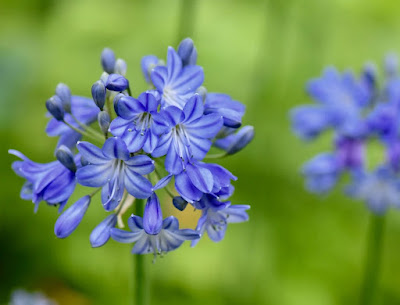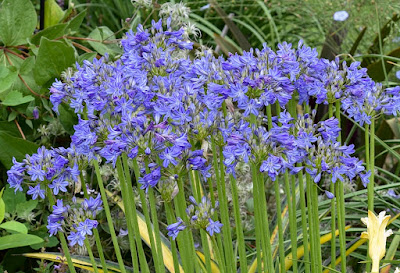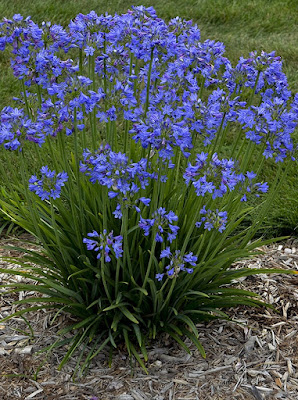Agapanthus Galaxy Blue - Galaxy Blue Lily of the Nile has medium-green leaves with dark-blue flowers on medium-tall dark purple scapes...
Agapanthus Galaxy Blue also called as Galaxy Blue Lily of the Nile, Agapanthus praecox Galaxy Blue, is a cultivar in the genus Agapanthus. This cultivar was discovered by Hans A Hansen in July of 2012 in a trial field at a wholesale perennial nursery in Zeeland, Mich., USA.
DESCRIPTION OF AGAPANTHUS GALAXY BLUE - GALAXY BLUE LILY OF THE NILE
Agapanthus Galaxy Blue is a croos between Agapanthus campanulatus subspecies patens ‘Mooreanus’ as female or seed parent and Agapanthus ‘Prolific Blue’ as male or pollen parent on Jul. 12, 2010. The planat has been asexually propagated by division and shoot tip tissue culture at the same wholesale nursery in Zeeland, Mich. since 2012 and has proven to be stable and reproduces true to type in successive generations of asexual reproduction.
It is a herbaceous perennials which reaching 32 cm tall by 80 cm spread with winter-hardy compact, dense mounded plant habit. The plant grows in upright clumps from fleshy rhizomes that produce short, tuberous roots. Tufts of leaves are produced on short stems. The leaves are clean, lanceolate, medium-green, about 30 cm long and about 1.6 cm across, and goes dormant in the winter.
Galaxy Blue Lily of the Nile bloom primarily in mid-July and with repeating new scapes into mid-September for about eight weeks on the pseudo-umbel, dark purple inflorescence that are initially sheathed in two bracts. The flowers are funnelform, about 30 to 50 per scape, about 3 cm in diameter, dark-blue, non-fragrant. The flowers remain effective from late-July repeating into mid-September for approximately eight weeks.
AGAPANTHUS GALAXY BLUE - GALAXY BLUE LILY OF THE NILE CARE AND CULTURE
Cultural information should only be used as a guide, and should be to be adapted to suit you. Your physical location; where you grow your plants, how much time you have to devote to their care, and many other factors, will need to be taken into account. Only then can you decide on the cultural methods that best suit you and your plants.
Light:
Agapanthus Galaxy Blue thrive in full sun and need 6-8 hours of sunlight each day. They can be grow as a houseplant in bright light and requires good lighting in the summer, with a lack of light, the flower stalks are extended, and they need support. They grows best at a window with a south, southeast, or southwest orientation. This plant blooms best when grown in full sun.
Temperature:
Galaxy Blue Lily of the Nile need the cool to cold temperatures and can grow in USDA zone 6 through 11. In summer, the optimal temperature is at around 25 ℃. In winter a low temperature of 10-12 ℃ is desirable. When temperatures dip below freezing, the plant will require some winter protection, a few layers of horticultural fleece can also be thrown over the leaves. The plant grown in containers can moved to a frost-free greenhouse or a conservatory for the winter.
Substrate and growing media:
Agapanthus Galaxy Blue is planted just deep enough to cover the roots, spacing them about 8” apart. A single plant will fill a 12” pot, or use more in larger pots. Use well-drained potting mix, as they do not tolerate waterlogged soil. For good growth and abundant flowering the plant requires a nutrient mixture of clay-sod, humus, leaf soil and sand (2: 2: 1: 1).
Young and medium-sized plants are transplanted every spring, adult plants every 3-4 years. The plant does not like frequent transplants, blooms best in a close pot. When transplanting, be careful, as the rhizomes are carelessly broken when carelessly applied and the plant may not tolerate the transplant.
Watering:
Keep the plant well watered when growing, but allow it to dry out in winter. Making sure that the substrate does not dry out completely. If watering is excessive, water may stagnate, which leads to acidification of the soil.
Fertilizer:
During the growing season, the plant can be fertilize every 10 days (April to October). In the winter, during the rest period the plant is not fed.
Rest period:
Agapanthus Galaxy Blue is keeped outdoors as long as possible in the fall because they need a cold period in order to flower well the next season. However, do not subject your plants to heavy frost (28ºF). In winter the plant should be place indoors in a cool location with bright light such as in a mudroom, by a window in a garage that does not freeze, or in a room that is kept cool (45ºF - 55º F). Keep your plant on the dry side, watering perhaps once a month. If plants are kept too warm during the winter they will force into bloom before summer.
In winter, reduce watering and do not fertilize during this time. In the spring, after danger of frost has passed, place your plant outdoors, gradually moving them from part sun to full sun, and begin watering and fertilizing regularly.
Propagation:
Galaxy Blue Lily of the Nile can be propagated from division. Root bound potted plants can be divided every 4-5 years. Division is best done after flowering, but it can be done any time. Use a very sharp knife to cut the clump into sections, each with roots attached, and pot the sections up. Divisions may not flower until the following year.

















COMMENTS